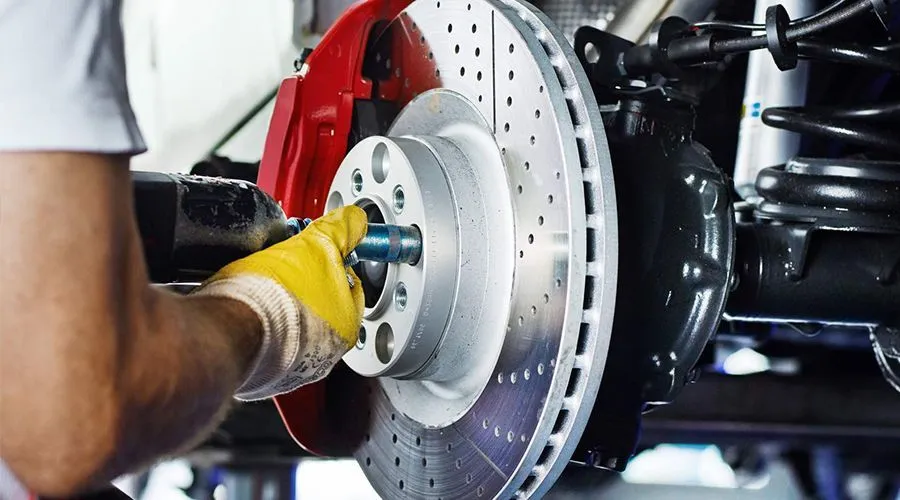
Brake disc: operation and maintenance
Content
The brake disc is one of the components of your vehicle's braking system. Thanks to the friction of the brake pads on the disc, it slows down and stops your car. As such, the brake disc contributes greatly to your safety on the road and must be replaced periodically to maintain braking performance.
🚗 What is a brake disc?

There are different braking systems for cars: drum brake и disc brake are basic. Disc brakes have been used in production vehicles since the 1950s, similar to bicycle brakes.
The disc braking system consists of several components located behind each wheel of the vehicle:
- Le Brake disc ;
- . Brake pads ;
- Thestopping support.
The brake disc is the central part of this braking system. It is a metal disk attached to the wheel hub that rotates with it. It is used to slow down the wheel to stop your car. Note that the brake pad is fixed and clamps on the disc to slow and then stop the wheel from spinning.
Is the brake disc ventilated or full?
Brake discs are of several types:
- . solid brake discs, solid and without grooves. This is the oldest and cheapest brake disc.
- . grooved brake discs... Their grooves on the surface increase friction and thus help to cool the disc.
- . perforated brake discsthat have holes in the surface. These holes serve the same function as the grooves in the spline brake discs. They also make it easy to drain rainwater.
- . ventilated brake discswhich have an empty space between the two sides of the disc to aid ventilation.
A good cooling of the brake disc is essential because the friction caused by the action of the brake pads during braking causes it to heat up significantly. The brake disc can exceed 600 ° C.
The ventilated brake disc is better at dissipating heat than a one-piece brake disc, which makes the brakes more efficient. However, you must respect the original brake discs on your vehicle when replacing them.
🔍 How does a brake disc work?
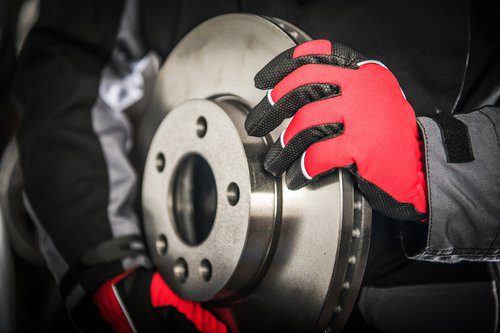
The brake disc attached to the wheel hub is also connected tostopping support and platelets which will rub the disc on each side if the mechanism is activated, thus slowing down its rotation.
When you want to slow down your vehicle, you press the brake pedal. This drives the piston, which creates pressure in brake fluid. The latter activates the brake caliper, which then presses the pads against the brake disc. Thus, the inertia process is blocked and the car stops.
🗓️ When to change the brake disc?
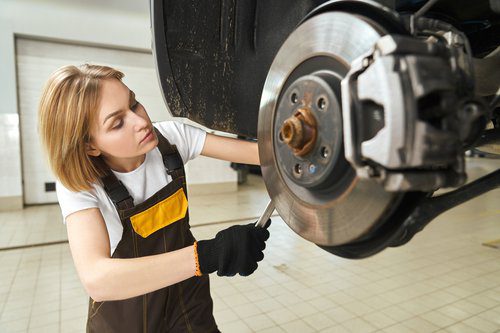
Brake system components: Wear parts is often used and therefore requires periodic replacement. Brake disc wear depends on the weight of the vehicle, driving style and the type of road you are traveling on.
Indeed, regular braking and winding roads wear out discs faster than more frequent use of engine braking or motorway travel.
Here are the symptoms to alert you to brake disc wear:
- La brake pedal hard when your leg presses on him;
- La pedal soft or elastic;
- La brake pedal shells to the floor without resistance;
- Brakes give jerks ;
- Do you hear braking noise ;
- Your braking distances have an elongated shape.
Do not wait until you feel the symptoms of a broken brake disc before changing it. Indeed, your stopping distance will increase significantly, and your safety and the safety of other road users will depend on it. You can check the wear of the brake discs on their thickness.
Your manufacturer indicates minimum quotas follow the rules of safe driving; refer to your vehicle's maintenance log. Change discs as you approach this level.
⚙️ Replacing the brake disc: every how many km?
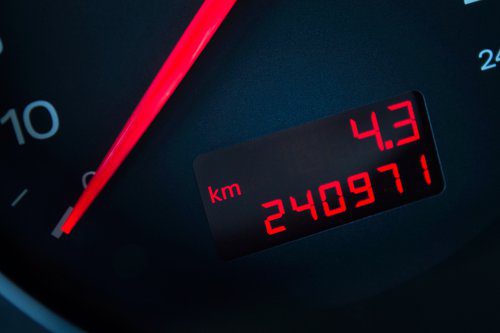
It is advisable to replace the brake discs on your car. every 60-80 km O. Obviously, this depends on the type of car and the manufacturer's recommendations, as well as your driving style. You need to change the pads every 30-40 km and discs are replaced every time the pads are changed.
Check the brake disc regularly for wear. The minimum thickness is indicated on each disc. If it is lower, a disk replacement is necessary. Your mechanic will check the wear on your brake discs every time your vehicle is serviced.
🚘 Why change brake discs?

Given the increasing weight of vehicles, braking is used more and more... As a result, the brake disc wears out faster. Its degradation also depends on the way of driving and the roads used. This is because the brake disc wears out faster on roads with a lot of bends than on highways.
Monitoring brake disc wear is important to know when to replace them: the more damaged the brake disc, the less effective the braking will be. Your stopping distance increasesrisking your safety and the safety of others. So be careful not to neglect changing brake discs!
🔧 How do I know if a brake disc has warped?
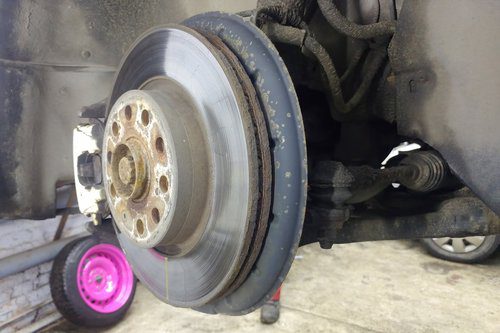
Un warped brake disc means that the surface of the disc has become uneven. As a result, braking becomes faster and less effective. A deformed brake disc is easily recognizable by the following signs:
- Le noise : the disc warped during braking;
- Thesmell : May smell like burnt rubber when braking;
- . vibrations in the brake pedal: this is the main symptom of a skewed brake disc.
Pay attention to how you feel when braking. You can easily recognize a warped brake disc during harsh and inconsistent braking with a vibration sensation when the brake pedal is depressed.
🔨 How to change brake discs?

Brake discs need to be changed periodically, approximately every 60–80 kilometers. When replacing, the brake pads must also be replaced. You should also replace the brake discs if they are damaged or deformed.
Material:
- socket
- Candles
- Tools
- Piston pusher
- Brake fluid
Step 1. Drive the vehicle on jacks.

Loosen the wheel nuts without removing them: it is easier to do this on the ground than when your car is in the air. Then raise the vehicle and place it on jacks for safe operation. Then remove the lug nuts and remove the lug.
Step 2: Remove the brake system
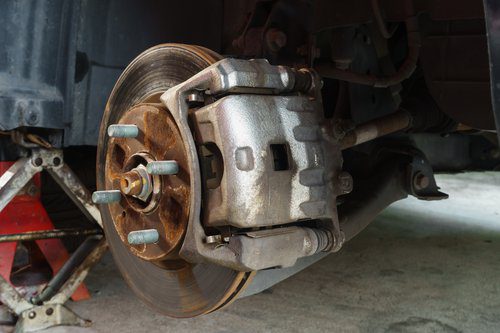
Removing the wheel gives access to the brake system. You should start by removing the brake caliper: remove the nuts holding it in the medium, then remove the caliper mounting screws. Be careful not to damage the brake hose or let it hang down: attach it to the frame so it stays high.
Loosen the screws securing the brake disc to the hub and remove them, then remove the hub from the cardan. Separate the two parts of the hub, freeing up the brake disc, which you can finally remove.
Step 3: Install the new brake disc
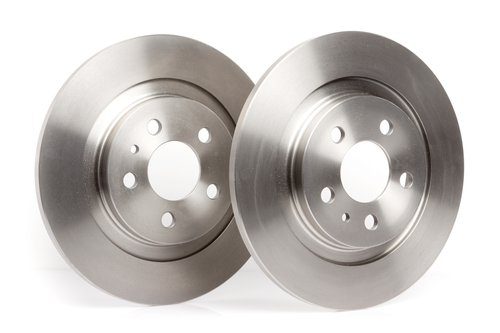
Install a new brake disc onto the hub. Replace the second part of the hub and its bearing, then tighten the retaining screws. Feel free to apply a little thread lock to keep it from falling apart over time.
Place the hub on the propeller shaft and install the nuts with the torque specified by the manufacturer. Then assemble the brake caliper. Here also apply thread lock to the screws and observe the torque recommended by the manufacturer.
Step 4: assemble the wheel

After reassembling the brake system, you can put the removed wheel back in place. Unscrew the nuts, then place the machine back on the jack to remove the jack stands. Get the car back and feel free to check your brake system to make sure everything is installed correctly. Your brake discs will have a running-in phase during which your braking is less effective: be careful on the road.
Now you know everything about brake disc! You will find them at the front of the car, behind each wheel. There may be disc brakes or drum brakes... In all cases, observe the frequency of the brakes, because regular replacement is necessary for your safety on the road.
